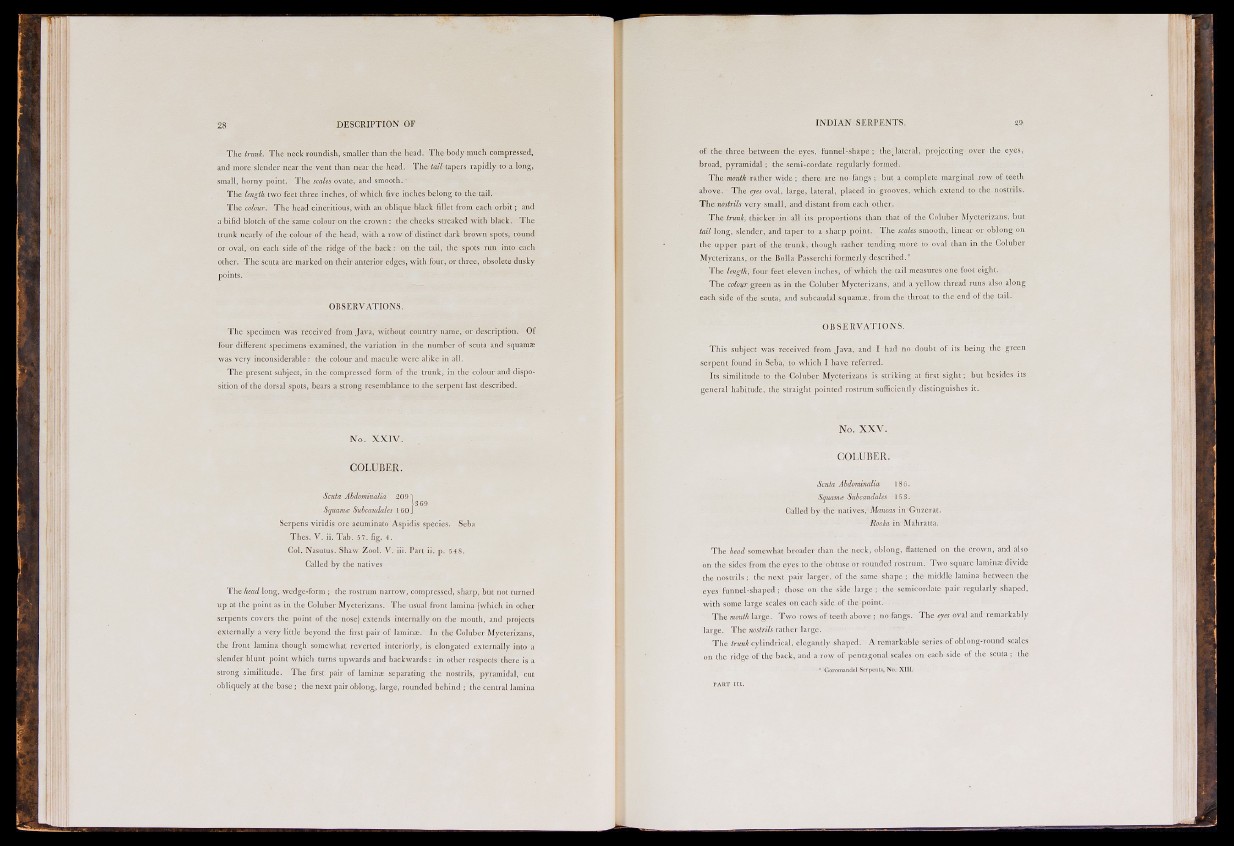
28 DESCRIPTION OF
The trunk. The neck roundish, smaller than the head. The body much compressed,
and more slender near the vent than near the head. The tail tapers rapidly to a long,
small, horny point. The scales ovate, and smooth.
The length two feet three inches, of which five inches belong to the tail.
The coloui-. The head cineritious, with an oblique black fillet from each orbit ; and
a bifid blotch of the same colour on the crown : the cheeks streaked with black. The
trunk nearly of the colour of the head, with a row of distinct dark brown spots, round
or oval, on each side of the ridge of the back: on the tail, the spots run into each
other. The scuta are marked on their anterior edges, with four, or three, obsolete dusky
points.
OBSERVATIONS.
The specimen was received from Java, without country name, or description. Of
four different specimens examined, the variation in the number of scuta and squamae
was very inconsiderable: the colour and maculas were alike in all.
The present subject, in the compressed form of the trunk, in the colour and disposition
of the dorsal spots, bears a strong resemblance to the serpent last described.
No. XXIV.
COLUBER.
Scuta Abclominalia 2091
[369
Squama: Suhcaudales 160 J
Serpens viridis ore acuminato Aspidis species. Seba
Thes. V. ii. Tab. 5 7. fig. 4.
Col. Nasutus, Shaw Zool. V. iii. Part ii. p. 54 8.
Called by the natives
The head long, wedge-form ; the rostrum narrow, compressed, sharp, but not turned
up at the point as in the Coluber Mycterizans. The usual front lamina (which in other
serpents covers the point of the nose) extends internally on the mouth, and projects
externally a very little beyond the first pair of lamina:. In the Coluber Mycterizans,
the front lamina though somewhat reverted interiorly, is elongated externally into a
slender blunt point whicli turns upwards and backwards : in other respects there is a
strong similitude. The first pair of lamina separating the nostrils, pyramidal, cut
obliquely at the base ; the next pair oblong, large, rounded behind ; the central lamina
INDIAN SERPENTS. 29
of the three between the eyes, funnel-shape ; the_lateral, projecting over the eyes,
broad, pyramidal ; the semi-cordate regularly formed.
The mouth rather wide ; there are no fangs ; but a complete marginal row of teeth
above. The eyes oval, large, lateral, placed in grooves, which extend to the nostrils.
The rtostrils very small, and distant from each other.
The trunk, thicker in all its proportions than that of the Coluber Mycterizans, but
tail long, slender, and taper to a sharp point. The scales smooth, linear or oblong on
the upper part of the trunk, though rather tending more to oval than in the Coluber
Mycterizans, or the Bolla Passerchi formerly described.*
The length, four feet eleven inches, of which the tail measures one foot eight.
The colour green as in the Coluber Mycterizans, and a yellow thread runs also along
each side of the scuta, and subcaudal squamas, from the throat to the end of the tail.
O B S E R V A T I O N S .
This subject was received from Java, and I had no doubt of its being the green
serpent found in Seba, to which I have referred.
Its similitude to the Coluber Mycterizans is striking at first sight; but besides its
general habitude, the straight pointed rostrum sufficiently distinguishes it.
No. XXV.
COLUBER.
Scuta Abdominalia 186.
Squama: Suhcaudales 15 3.
Called by the natives, Mancas in Guzerat.
Rooka in Mahratta.
The head somewhat broader than the neck, oblong, flattened on the crown, and also
on the sides from the eyes to the obtuse or rounded rostrum. Two square lamins divide
the nostrils ; tlie next pair larger, of the same shape ; the middle lamina between the
eyes funnel-shaped ; those on the side large : the semicordate pair regtdarly shaped,
with some large scales on each side of the point.
The mouth large. Two rows of teeth above ; no fangs. The eyes oval and remarkably
large. The nostrils rather large.
The trunk cylindrical, elegantly shaped. A remarkable series of oblong-round scales
on the ridge of the back, and a row of pentagonal scales on each side of the scuta ; the
* Coromandel Serpents, No. XIII.